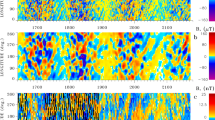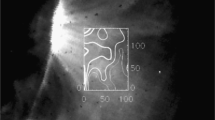Abstract
Several different mathematical methods are described which use the observed line-of-sight component of the photospheric magnetic field to determine the magnetic field of the solar corona in the current-free (or potential-field) approximation. Discussed are (1) a monopole method, (2) a Legendre polynomial expansion assuming knowledge of the radial photospheric magnetic field, (3) a Legendre polynomial expansion obtained from the line-of-sight photospheric field by a least-meansquare technique, (4) solar wind simulation by zero-potential surfaces in the corona, (5) corrections for the missing flux due to magnetograph saturation. We conclude (1) that the field obtained from the monopole method is not consistent with the given magnetic data because of non-local effects produced by monopoles on a curved surface, (2) that the field given by a Legendre polynomial (which is fitted to the measured line-of-sight magnetic field) is a rigorous and self-consistent solution with respect to the available data, (3) that it is necessary to correct for the saturation of the magnetograph (at about 80 G) because fields exceeding 80 G provide significant flux to the coronal field, and (4) that a zero-potential surface at 2.5 solar radii can simulate the effect of the solar wind on the coronal magnetic field.
Similar content being viewed by others
References
Biermann, L.: 1951, Z. Astrophys. 29, 274.
Billings, D. E.: 1966, A Guide to the Solar Corona, Academic Press, New York.
Bray, R. J. and Loughhead, R. E.: 1964, Sunspots, John Wiley and Sons, New York.
Broxon, J. W.: 1942, Phys. Rev. 62, 508.
Chapman, S.: 1943, Monthly Notices Roy. Astron. Soc. 103, 117.
Chapman, S.: 1957, Smithsonian Contrib. Astrophys. 2, 1.
Chapman, S. and Bartels, J.: 1940, Geomagnetism, Oxford University Press, London.
Chapman, S. and Ferraro, V. C. A.: 1940, Terrest. Magnetism Atmospheric Elec. 45, 245.
Eddy, J., Firor, J. W., and Lee, R. H.: 1967, Astron. J. 72 (7), 793 (abstract).
Gauss, C. F.: 1839, Allgemeine Theorie des Erdmagnetismus, Resultate aus den Beobachtungen des magnetischen Vereins im Jahre 1838, 1.
Godovnikov, N. V. and Smirnova, E. P.: 1965, Izv. Krymsk. Astrofiz. Observ. 33, 86.
Harvey, J. W.: 1967, unpublished computer program.
Harvey, J. W.: 1969, Ph.D. Thesis, Univ. of Colorado, Dept. of Astrogeophysics.
Hildebrand, F. B.: 1956, Introduction to Numerical Analysis, McGraw-Hill, New York.
Howard, R., Bumba, V., and Smith, S. F.: 1967, Atlas of Solar Magnetic Fields 1959–1966, Carnegie Institute of Washington, Publication No. 626.
Meyer, F.: 1967, Private communication.
Ness, N. F.: 1968, Ann. Rev. Astron. Astrophys. 6, 79.
Newkirk, G.: 1967, Ann. Rev. Astron. Astrophys, 5, 213.
Newkirk, G. A., Altschuler, M. D., and Harvey, J. W.: 1968, in Structure and Development of Solar Active Regions (ed. by K. O. Kiepenheuer), I.A.U. Symposium No. 35, D. Reidel Publ. Co., Dordrecht, p. 379.
Newkirk, G. and Harvey, J.: 1968, Solar Phys. 3, 321.
Parker, E. N.: 1958, Astrophys. J. 128, 664.
Parker, E. N.: 1964, Astrophys. J. 139, 690.
Parker, E. N.: 1965, Space Sci. Rev. 4, 666.
Pneuman, G. W.: 1966, Astrophys. J. 145, 242.
Rayrole, J., and Semel, M.: 1968, in Structure and Development of Solar Active Regions (ed. by K. O. Kiepenheuer), I.A.U. Symposium No. 35, D. Reidel Publ. Co., Dordrecht, p. 379.
Pneuman, G. W.: 1968, Solar Phys. 3, 578.
Pneuman, G. W.: 1969, Solar Phys. 6, 255.
Roka, E. G. v.: 1950, Z. Astrophys. 27, 15.
Rust, D.: 1966, Ph.D. Thesis, Univ. of Colorado, Dept. of Astrogeophysics.
Schatten, K. H.: 1968, Nature 220, 1211.
Schatten, K. H., Wilcox, J. M., and Ness, N. F.: 1969, Solar Phys. 6, 442.
Schmidt, H. U.: 1964, in NASA Symposium on Physics of Solar Flares (ed. W. Hess) NASA SP-50, p. 107.
Schmidt, H. U.: 1967, Private communication.
Semel, M.: 1967, Ann. Astrophys. 30, 513.
Sheeley, N. R.: 1967, Solar Phys. 1, 171.
Stenflo, J. O.: 1966, Arkiv Astron. 4, No. 13, 173.
Stenflo, J. O.: 1967, Acta Universitatis Lundensis, See. II, No. 35.
Takakura, T.: 1966, Space Sci. Rev. 5, 80.
Tandberg-Hanssen, E.: 1967, Solar Activity, Blaisdell Publishing Co., Waltham, Mass.
Weber, E. J. and Davis, L., Jr.: 1967, Astrophys. J. 148, 217.
Author information
Authors and Affiliations
Rights and permissions
About this article
Cite this article
Altschuler, M.D., Newkirk, G. Magnetic fields and the structure of the solar corona. Sol Phys 9, 131–149 (1969). https://doi.org/10.1007/BF00145734
Received:
Issue Date:
DOI: https://doi.org/10.1007/BF00145734




